More on Drawing Clothes
... feel the fabric
The importance of drawing clothes cannot be overemphasized. When clothing is drawn with attention to detail, the results are gratifying.
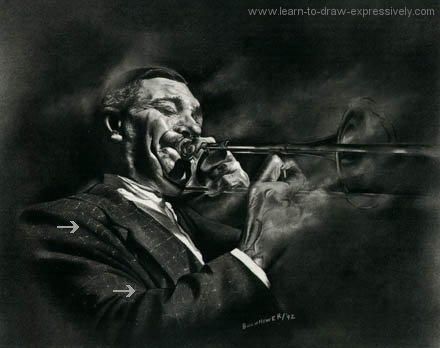
Jack Teagarden, jazz musician/vocalist
Before I address the sports jacket, I want to mention that this drawing was done on an 18 x 24 inch piece of white paper. Darkening a piece of paper this size with charcoal, requires careful attention in order to achieve a uniform background.
When the drawing was completely finished, the dark background and foreground were subtly interrupted with white wispy areas, to imply a smokey nightclub atmosphere. This was done with white chalk dust and brushes.
Let’s look at this 1940’s style woollen sports jacket.
The lower arrow indicates the bend at the elbow from which folds radiate. I’ve imposed a very simple pattern of heavy, dark folds to indicate the thickness of a woollen jacket. (A thinner fabric will hang differently. There will be more creases and folds. I'll demonstrate this in other examples .) The folds were done with 3B charcoal pencils and cheap brushes.
White chalk is used to create the pinstripes, which follow the contours of the folds in the jacket. They are not continuous, rather a little here and a little there, just as you would see in a tweed material. If the pinstripes in the clothing had been drawn as continuous lines, we would lose the subtle reality of what in this case is a tweed fabric.
The pinstripes over the entire jacket were done with the “less is more” philosophy. Particularly at the forearm . . . just a dot of white chalk here and there. When drawing clothes, this kind of subtlety will dramatically enhance the reality of the fabric.
The pinstripes follow the contours of the jacket. The upper arrow points to one example where the stripes are obviously curved to follow the folds in the jacket.
Drawing Clothes - More About Jackets
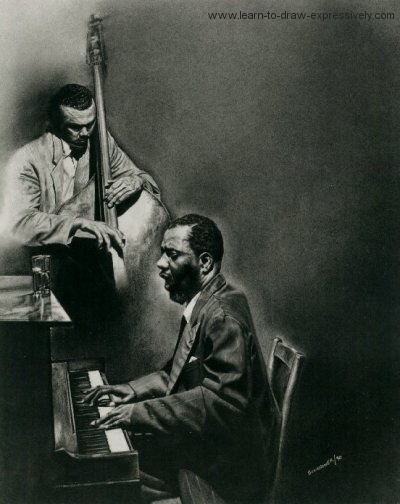
Thelonious Monk (piano), Charlie Mingus (bass)
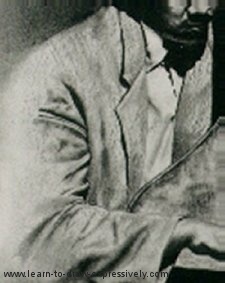
I'm going to discuss the jacket on the right, but I wanted to show you both jackets so you can see the difference in texture.
Because the jacket on the left is in the background, it is not as detailed, however it does play a role in the overall composition. For the sake of contrast, I didn't want both jackets to be the same texture.
To get the rougher texture in the jacket on the left, I sharpened a 1B charcoal pencil and dragged the side of it lightly across the paper.
By doing so, the tooth in the paper picked up the charcoal and gave the jacket a mottled or rough appearance.
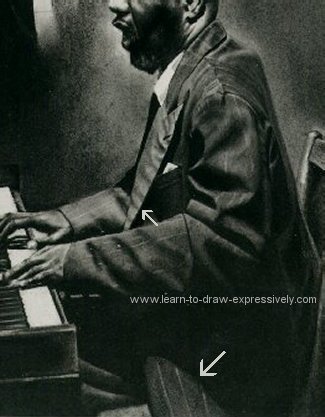
Now let's look at the jacket in the foreground.
In order to imply a smooth fabric in this suit jacket, brushes were used. Tonal contrasts are used within the brushed areas in order to add variety.
For the sake of contrast, I used the sharpened tip of a hard lead HB charcoal pencil. (The arrow behind the lapel of the jacket indicates one of the areas where I used an HB pencil. Note the very sharp edge of the entire lapel, and the clearly defined dark shadow running behind the lapel.)
As in the first image on this page, this jacket also has pinstripes. The pinstripes were applied with the same "less is more" technique. In this case, the pinstripes were done overtop of the charcoal using a kneaded eraser. I shaped the eraser to a point and used it very much as a pencil.
Note that the pinstripes are subtly applied, and that they follow the contours of the jacket. They disappear in the shadow of a fold, and then reappear.
Note the arrow at the bottom of the drawing. It indicates a highlighted area where the pinstripes are most clearly defined. This reinforces the overall feeling of the pinstriped suit, but it doesn't hit the viewer over the head. Once again, when drawing realistic texture, less is more.
Note the rippled look in the jacket lapel. Each ripple is created with a dark shadow, and its accompanying highlight. This imitates the way natural light falls across the ripples in the lapel.
When drawing clothes, look for surface details on the clothing, which can bring certain areas to life.
- Note the buttonhole on the lapel;
- Note the stitching on the shoulder seam;
- Note the stitching on the breast pocket;
- Note the contrast created by the handkerchief in the breast pocket.
And finally, recognize the logic in the pattern of folds throughout the jacket. Each fold has a beginning and an end...very important. Remember, drawing clothes is an art in itself.
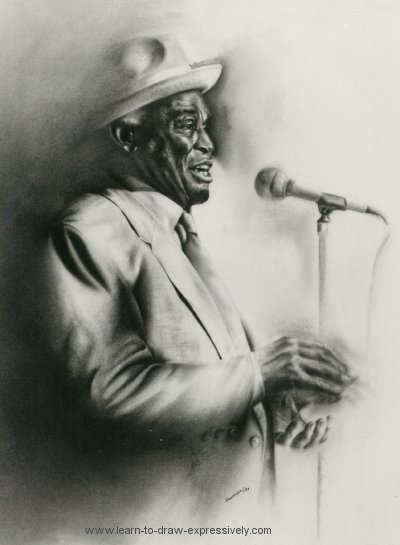
Willie Dixon, blues singer/songwriter
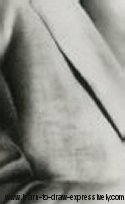
I'm showing Willie Dixon wearing an off-white suit jacket made of a woven linen fabric.
To suggest the weave of the fabric, I combined the following techniques (I don't know how much of this your monitor will pick up):
- I very lightly drew horizontal and vertical lines using a sharp HB charcoal pencil
- I lightly pulled the lead of a 1B charcoal pencil across the paper to catch the tooth of the paper.
- Using blending stumps (dipped in 3B charcoal dust), I randomly smudged different spots in that area.
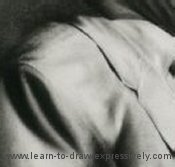
When drawing clothes, look for variety in the texture of the fabric. Variety makes the clothes look real.
Note the following in the shoulder area:
- The two large dark folds on the left
- The hint of a shoulder seam
- The white untouched areas of paper
- Various light to mid-tone to dark shaded areas (done with vine charcoal, 3B charcoal, brushes and blending stumps.)
- Sharply delineated edge running down the lapel of the jacket (done with an HB charcoal pencil).
Return to Drawing Clothes ... a Sense of Touch or ...
To search my site for more on drawing clothes, enter your search term in the box below, and click on the Search button. (Google ads may appear at the top of the results page ... your search results will be just below.)
Return from Drawing Clothes to
Home Page




